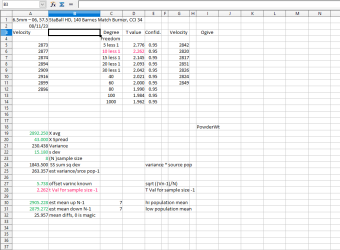Original posting guy here....I spent about 10 years of my career doing testing and statistics to set specifications for electrical instruments. We always strived for sample sizes of 30 or more to get the best confidence and proportion intervals. The Hornady guys in the video that I posted earlier made a very strong argument against looking for nodes. Since they have the resources to shoot a hundred or more rounds at each powder charge at a given seating depth, they concluded that time was best spent on selecting different types of bullets and powder for the best accuracy, and that there were no velocity nodes. They seated from 20 to 30 thousandths off the lands, and also out an additional 100 thousandths, which made very little difference in accuracy (don't remember about velocity). Worth noting is that if you shoot three rounds at some powder charge or seating depth that are really poor with velocity or POI goals, throw out that charge or seating depth. With my inexpensive 243 (which shoots 1 MOA at 400 yds with factory match ammo), new and once fired brass with my reloads both performed the best at 38.6 gn, both with a node and with good POI at 100 yds. At this juncture, and I no longer know why, but that's the load I'm sticking with. My buddy's 6.5 PRC had some great vertical dispersions at different charges, but with linear average velocity over powder charges and some pretty large SD's at good POI's. I think a very important final step is to take the final load (charge and seating depth) and shoot 20 to 30 rounds, perhaps 3 per target spot, and blend them together somehow mathematically (to get a larger sample size) before doing the scope zeroing.


